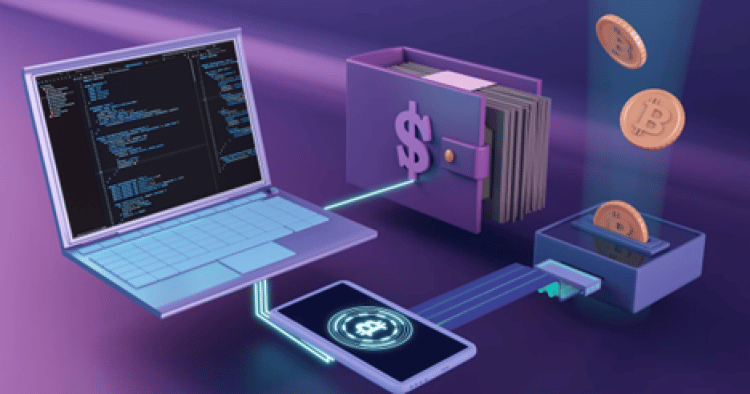Two specific terminologies are frequently used when discussing blockchain: cryptocurrency and dApps, or decentralized applications. While investors have focused more on cryptocurrency, businesses have started to use dApp development more frequently.
Businesses from various sectors are already creating dApps to boost their profits. They either created dApps to manage their data and streamline business processes or offer clients services.
There are three main network architectures to consider when developing a digital product or service for your company: centralized, distributed, and decentralized. dApp blockchain application development cannot be classified as a decentralized application, even though blockchain technologies are frequently built on decentralized networks.
Decentralized apps, or dApps, are created; as a result to enable enterprises to govern their own digital assets and data.
What are dApps?
Decentralized applications are pieces of software that communicate with the blockchain in DeFi (Decentralized Finance), monitoring the status of every user on the network. Today’s dApps feature a similar user interface to any other website or mobile application, but smart contracts serve as the foundation of their functionality.
To access services like games, trading, stake, earning interest, etc., that aid businesses with engagement, dApps frequently require the user’s token. A decentralized app is undoubtedly one of the most widely used blockchain trends in the industry vertical since it is equitable to all business scales.
All you need to know now is “how to generate money with dApps” if you have already begun developing your decentralized mobile app. This article explains how to generate money with dApps and introduces you to the finest dApps for making money. It also discusses various dApp monetization strategies. So be sure to stick around to the finish.
What Justifies dApps’ Business Relevance?
Businesses stand to gain significantly from incorporating dApps into their daily operations. dApps can improve business operations by streamlining mundane tasks and enhancing client privacy.
Here are some benefits of adopting a dApp for your company:
- Less Downtime
dApps function on P2P networks with blockchain support. There isn’t a single point of failure, which avoids service outages and cuts down on application downtime. The network will still run smoothly even if one of the computer nodes crashes.
- Improved Data Security
User data is dispersed over thousands of computer nodes and shared databases on a dApp. Since every node would need to be compromised, even if one were to be hijacked, it would be impossible to steal all the data.
- Reduces Costs
Businesses can save money by using dApps, especially since they eliminate the need for middlemen. For instance, because a DeFi lending marketplace encourages direct interaction with borrowers, moneylenders can save on middlemen expenses.
- Improvements to Borderless Operations
It is challenging to halt the operations of dApps because they utilize several servers, especially in a specific area. Governments are unable to impose restrictions on an application since there is no standard IP address. This makes international company expansion easier for companies.
- Greater Trust
The decentralized nature of dApps contributes to greater project confidence. A dApp’s architecture can always be changed, and users can see and approve those changes. This avoids the issue with centralized apps, where developers frequently introduce modifications arbitrarily without consulting users.

Commercial dApps and Their Business Models
Experts advise organizations to adhere to the monetization models that best suit their operational procedures. Here are a few instances of dApps that are making money in several industries in addition to that:
Gaming dApps
Gaming dApps players compete with one another in gaming dApps. Here you get the option of monetization as a company investing in gaming dApps by sponsoring or promoting the content of games that are similar to your own.
Apps for Decentralized Exchange
Decentralized stock exchange apps give users the option to trade market shares. Every transaction fee associated with a particular stock exchange is paid to the investors in a predetermined amount.
Marketplace
The NFT marketplace lets users sell, buy, and even generate non-fungible tokens as part of current crypto trends. If your company uses a similar procedure, you can leverage the transaction fee model to raise NFTs’ overall revenue.
dApps for Payment
With the use of payment dApps, users can send anonymous Ethereum transactions in real-time. In this case, the subscription package of the sender and the recipient’s location determine the transaction charge for each transfer.
How can Businesses Boost their Potential with dApps Development?
It’s time to find out how to monetize dApps now that you have a solid understanding of what a dApp is and why businesses should create one. Here are some of the most well-liked monetization techniques you may use to make money with your dApps.
Launch of the Token Sale
The most important dApp business and revenue model to take into account is to crowdfund a project and support it with an asset token.
If you choose to go in this direction, you must bear the following points in mind:
- The essential features of your decentralized app
- Access was granted to the network
- Paid out profits to token holders
Fees for Transactions
The transaction fees model, which you can find in many dApps monetization guidelines, is another response to the question of whether you can generate money with dApps. One of the most lucrative methods to earn money by creating dApps is charging people to utilize your service.
Subscriptions
Another excellent option to monetize your decentralized application is through the subscription model. You can charge your users to access your dApp on a monthly, quarterly, or annual basis. As an alternative, you can also employ the usage-based approach, in which consumers are only charged for the services they choose.
The time-based subscription model’s ability to estimate income is one of its most robust features. It is also a fantastic technique to generate substantial rewards.
Advertisements
Ads do, in fact, find a place in the answer of how dApp development makes money, despite being a still-very-new/less-used blockchain business and monetization strategy.
As a result, you want to consider including it in your list of dApp monetization techniques.
Donations
An additional donation button to your application or website can help you earn minimal revenue. You can even share its URL with other social entrepreneurs if your dApp initiative aims to address a global issue or advance a social cause.

Crowdsale
For new dApps with cutting-edge features, this monetization strategy is very popular. The most practical approach for raising money for your dApp is crowdsale. Tokens must be created and distributed to users in return for their project investment.
Even if this type of monetization can help you raise a lot of money, you still need a strong marketing strategy to draw in investors.
Premium Options
Charging users to access particular features is another way to monetize your dApp. The concept is to charge consumers a fee to access the advanced capabilities of your dApp while making the essential functions accessible for free.
Make Digital Products
CryptoKitties is one of the best instances of an Ethereum app that uses this monetization approach to generate revenue.
CryptoKitties created generation 0 kittens and distributed them to platform users so they could retain them as collectibles. They convinced consumers to invest in digital products by making the cats useful, distinctive, and trending online.
Using Referrals
Referral marketing, which has been shown to be the driving force behind the success of e-commerce apps, can also be considered when determining how to monetize Ethereum-based decentralized applications. In reality, you may promote a variety of Blockchain-powered platforms on the internet right now by clicking on a link to one of their websites.
Steps to Develop dApps for your Business
With an anticipated revenue rise of dApps market share is expected to reach the valuation of $368.25 billion by 2027 and a 56.1% CAGR, dApp development is rising in popularity as companies seek to gain from the open-source, safe, and trustless characteristics of blockchain technology. Businesses may use the potential of blockchain to create dependable and secure applications that can influence their operations with the appropriate idea and development team.
Knowledge of the tools accessible for blockchain development is the first and most important element needed to design a dApp. For instance, Solidity programming knowledge is a need if you wish to create a dApp on the Ethereum network.
The essential stages for creating a dApp are listed below:
- Describe your dApp concept and evaluate its viability.
- Select the features that will be included in the dApp.
- Choose the right blockchain platform.
- Create the user experience and interface.
- Begin the development process.
- Check the dApp for bugs and other problems.
- Deploy the program.
Final Thoughts
You may want to think about hiring blockchain developers or a blockchain development business if you don’t already have an in-house blockchain development team. You can talk to them about your dApp concept and collaborate with them to create a fully functional model of your dApp.
Additionally, due to lower development costs and superior work quality, working with a specialist blockchain development business is considerably superior to using an internal team.
Author Bio:
Sam Anderson is a technical content writer who loves to explore and scroll through social media to learn and understand what really makes a business tick. He is particularly interested in the real world application of tech in building a business from the ground up to the upcoming user friendly world.













Leave a Reply